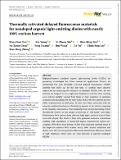Files in this item
Thermally activated delayed fluorescence materials for nondoped organic light-emitting diodes with nearly 100% exciton harvest
Item metadata
| dc.contributor.author | Fan, Xiao-Chun | |
| dc.contributor.author | Wang, Kai | |
| dc.contributor.author | Shi, Yi-Zhong | |
| dc.contributor.author | Sun, Dian-Ming | |
| dc.contributor.author | Chen, Jia-Xiong | |
| dc.contributor.author | Huang, Feng | |
| dc.contributor.author | Wang, Hui | |
| dc.contributor.author | Yu, Jia | |
| dc.contributor.author | Lee, Chun-Sing | |
| dc.contributor.author | Zhang, Xiao-Hong | |
| dc.date.accessioned | 2023-03-22T17:30:08Z | |
| dc.date.available | 2023-03-22T17:30:08Z | |
| dc.date.issued | 2023-02-01 | |
| dc.identifier | 283837261 | |
| dc.identifier | 6eaf558a-0925-4502-9b28-83bd4fa12faa | |
| dc.identifier | 85166953640 | |
| dc.identifier.citation | Fan , X-C , Wang , K , Shi , Y-Z , Sun , D-M , Chen , J-X , Huang , F , Wang , H , Yu , J , Lee , C-S & Zhang , X-H 2023 , ' Thermally activated delayed fluorescence materials for nondoped organic light-emitting diodes with nearly 100% exciton harvest ' , SmartMat , vol. 4 , no. 1 , e1122 . https://doi.org/10.1002/smm2.1122 | en |
| dc.identifier.issn | 2688-819X | |
| dc.identifier.other | RIS: urn:72403DC94D26C945333B2E07EAA362A0 | |
| dc.identifier.uri | https://hdl.handle.net/10023/27243 | |
| dc.description | Funding: This study was supported by the National Natural Science Foundation of China (Nos. 52130304, 51821002, 52003185, and 52003186), the National Key Research & Development Program of China (Nos. 2020YFA0714601 and 2020YFA0714604), Suzhou Key Laboratory of Functional Nano & Soft Materials, Collaborative Innovation Center of Suzhou Nano Science & Technology, and the 111 Project. | en |
| dc.description.abstract | High-performance nondoped organic light-emitting diodes (OLEDs) are promising technologies for future commercial applications. Herein, we synthesized two new thermally activated delayed fluorescence (TADF) emitters that enable us, for the first time, to combine three effective approaches for enhancing the efficiency of nondoped OLEDs. First, the two emitters are designed to have high steric hindrances such that their emitting cores will be suitably isolated from those of their neighbors to minimize concentration quenching. On the other hand, each of the two emitters has two stable conformations in solid films. In their neat films, molecules with the minority conformation behave effectively as dopants in the matrix composing of the majority conformation. One hundred percent exciton harvesting is thus theoretically feasible in this unique architecture of "self-doped" neat films. Furthermore, both emitters have relatively high aspect ratios in terms of their molecular shapes. This leads to films with preferred molecular orientations enabling high populations of horizontal dipoles beneficial for optical out-coupling. With these three factors, OLEDs with nondoped emitting layers of the respective emitters both achieve nearly 100% exciton utilization and deliver over 30% external quantum efficiencies and ultralow efficiency roll-off at high brightness, which have not been observed in reported nondoped OLEDs. | |
| dc.format.extent | 11 | |
| dc.format.extent | 3335832 | |
| dc.language.iso | eng | |
| dc.relation.ispartof | SmartMat | en |
| dc.subject | Dual conformations | en |
| dc.subject | Horizontal orientation | en |
| dc.subject | Organic light-emitting diodes | en |
| dc.subject | Self-doping | en |
| dc.subject | Thermally activated delayed fluorescence | en |
| dc.subject | QD Chemistry | en |
| dc.subject | NDAS | en |
| dc.subject | MCC | en |
| dc.subject.lcc | QD | en |
| dc.title | Thermally activated delayed fluorescence materials for nondoped organic light-emitting diodes with nearly 100% exciton harvest | en |
| dc.type | Journal article | en |
| dc.contributor.institution | University of St Andrews. School of Chemistry | en |
| dc.identifier.doi | 10.1002/smm2.1122 | |
| dc.description.status | Peer reviewed | en |
This item appears in the following Collection(s)
Items in the St Andrews Research Repository are protected by copyright, with all rights reserved, unless otherwise indicated.

